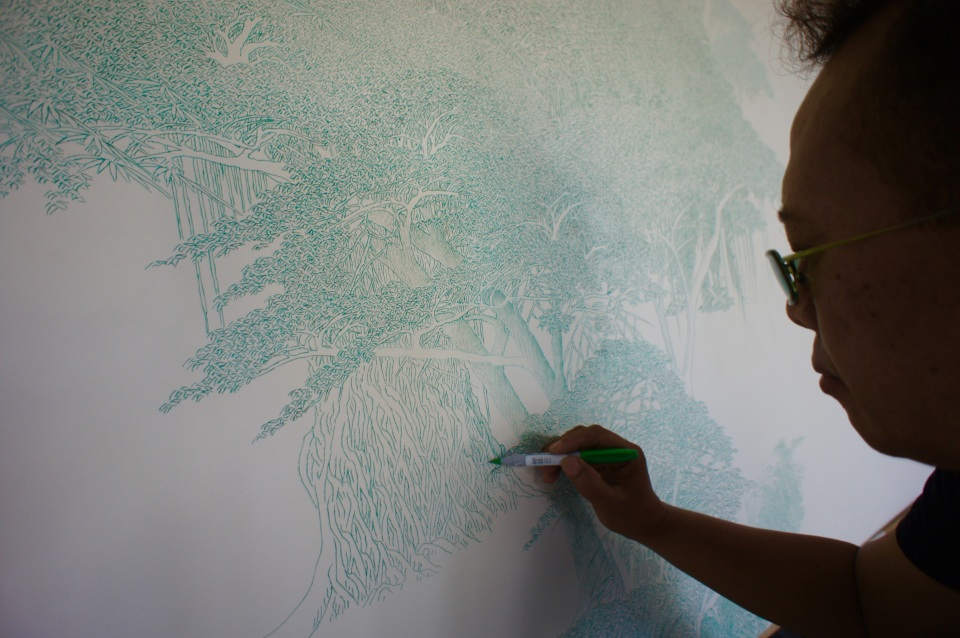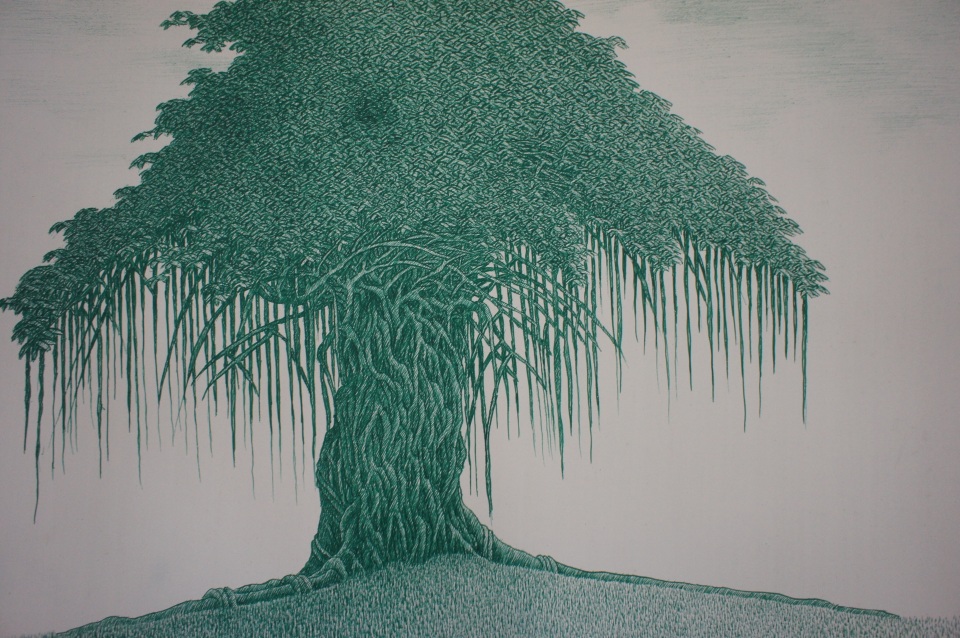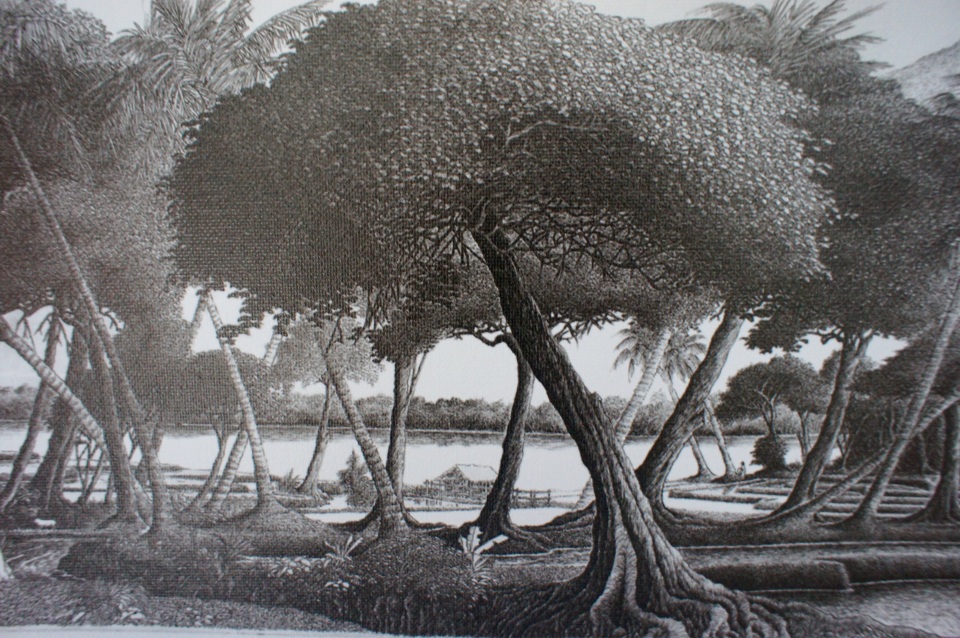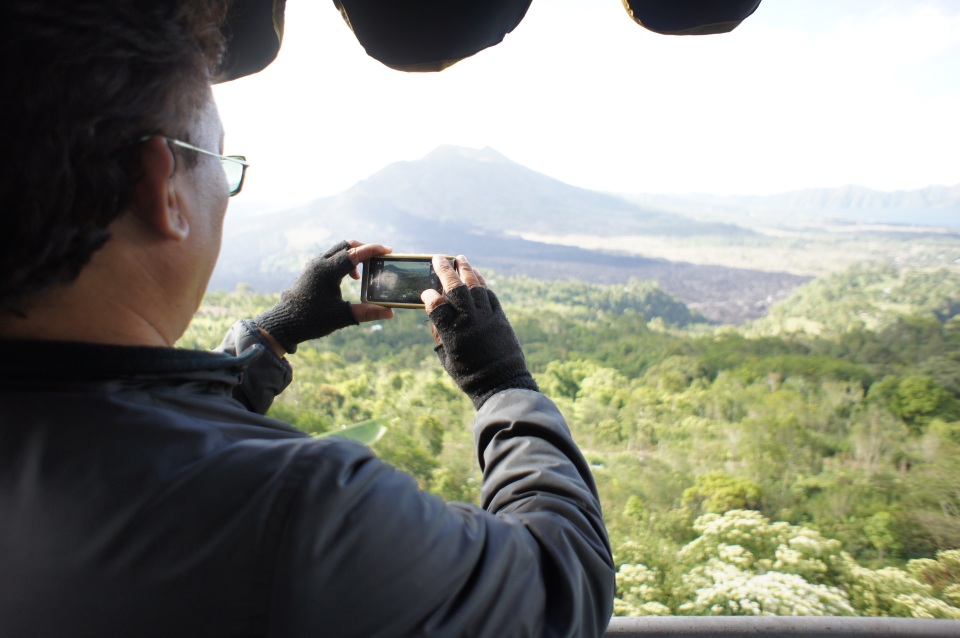On a quiet side street tucked away from the hustle and bustle of central Ubud, Java born and Borneo raised artist Malik sits day and night with his face only inches away from a canvas.
Residing in the cultural and artistic center of Bali, Malik’s quaint studio is nestled amidst daily ceremonies and serene views of nature, a short distance from many of the landscapes he uses as his main subjects. He is known by many in the area for being the ‘Sharpie Artist’, an Ubudian who recreates images of Bali’s nature scenes in monochrome drawings of fine detail and muted colors. Malik has been honing his craft for 17 years now, cultivating a technique that sets him apart from his traditional artist neighbors on the island. As Malik points out, “I don’t want to follow with tradition, I want to bring something different.”
What was it like moving back and forth from Java to Borneo as a kid? Did your family support your talent at a young age?
I moved from Java to Borneo when I was five, and then back to Java to go to middle school and high school, and then after I finished school I went back to Borneo. In Java people work very hard all the time just to survive. I don’t remember my first years in Java but my memories of growing up in Borneo were in a very natural setting. My family would always be in the jungle and by the river, always swimming. I remember when I was about seven years old I would roam through the jungle harvest mushrooms and eating them. I knew which ones were poisonous and which ones weren’t. Borneo was an interesting place to live because of all of the many nations living on the island. It was very diverse. I didn’t mind moving back and forth. I liked Java better because I went to a good school and the tradition and village are special to me because it’s my birthplace. I first lived with my grandmother when I went to middle school, and then my uncle when I went to high school, which I really liked.
My family supported me and they didn’t support me. They didn’t know I had talent, but they didn’t pull me away from it either. As a child, my parents were both busy with their lives and didn’t have much time to pay attention to my artistic interest. Their work was more important than paying attention to an artistic craft. My father was an elementary teacher and my mother was busy in the kitchen and home life. I remember at one point when I was young my father, just for fun, drew a mural on the wall with marker. I’ll never forget this because it was my first time seeing a panting on the wall by marker. At ten years old I moved back to Java to live with my grandmother and I started drawing nature scenes on paper. I loved doing it, and noticed that I was good. That’s when other people started to notice that I had a natural talent.
At what point in your life did you know that you could pursue art seriously?
In 1997 after I had just moved to Bali. I moved here with my wife because her brother was here, and I became a taxi driver. I was driving all over the island. My brother-in-law said, “Don’t be a taxi driver if you have talent.” So, I tried it on the side to see if I could make any money, selling illustrations just on paper with no studio. People were interested in my work, and that’s when I knew that I could do it seriously. I was just planning on driving a taxi and doing art as a hobby.
Do you have any formal training, or are you self taught?
(Smiles) I am self taught. I had talent and knew it. I just went on with my imagination and did what I wanted. Nature in bali is such an easy subject, temples, rice fields, there are subjects all around. I would go out on my motorbike and then I would find an idea to sketch. I never found a teacher because my principle is that I don’t want to be the same. I don’t want to copy. I must do different work. I never even looked at the work of other artists because I was afraid that if I drew too much inspiration I would subconsciously copy. If I copy, I am the same as everyone else here.
Tell me the story about your eye.
About ten years ago my hobby was badminton, and I used to play about two times a week. One day I was playing near the net and the opponent was only a meter away and he hit the shuttlecock right at me, and the cork base hit my eye. I felt something move through my eye, like the ocean, and slowly slowly it got darker. It was blood. They took me to the hospital and eight days later I was back home. In Singapore they said it was a damaged retina. In Bali the doctors aren’t very specific so I didn’t get a clear diagnosis, he just the outer part of my eye was ripped. At first I could see a little bit, like three dots sitting in blackness. I didn’t like this, it was too distracting. I prayed to God just make me blind in that eye. He answered my prayers.
Have you played badminton since then? (laughs) I cannot swing the racket anymore because my depth perception is off. Of course, this also affects my work as an artist.
You’ve been making art for nearly two decades now. How has your process changed and your confidence developed over the years?
When I moved to Ubud I would look around for beautiful landscape scenery and then go back and try sketching it from memory on only drawing paper. After the sketch, I would then use pens and markers, but I relied on sketching with every piece. When I got connected with the man in Singapore who would soon become my agent, he looked at my work on paper and said that I was skilled, but in order to sell it he wanted it on canvas. So, I followed his request and started working on canvas. In 1998 I stopped sketching beforehand and just started sitting with a picture and using marker from beginning to end. I don’t remember why I stopped sketching altogether, I just remembered at that point I was beginning to trust myself and knew that I wouldn’t make mistakes. Over the years as I have moved forward as an artist I have discovered that by trusting myself I can only get better.
How does your blindness affect the process and outcome of your work?
It is much more difficult to make art with a blind eye. Especially depth perception. Before I went blind I was able to sit and work for a very long time and focus on the fine details. Now, after two or three hours I get headaches from focusing so much through one eye, and I have to get up and move around. When I compare my work from before the accident to my work now, I wouldn’t say it has gotten better or worse, it’s just different.
Do you have a name for your technique?
I don’t have a name for it, but many people have come by my studio and said “This technique is called pointillism.” I didn’t start this process having the name of a technique in mind, I just started doing it because it worked for me. People have different terms for it. It’s not just pointillism because I also incorporate just as many lines and circles as I use dots. its a combination of the three. I don’t care about what people call it, as long as it works for me.
You seem to be proficient using landscapes as your subjects. Have you ever recreated images of anything else?
At one time a Chinese lady from Singapore came to me and asked me if I could do a picture for commission. It was a picture of her breasts. I did it, and the process was just as interesting as any other painting I do, it just brought up different emotions. It was also easy because I copied from a photo she gave me. Many tourists who are familiar with my work bring me portraits of them, photos of their family and other stuff they want done. Usually I turn them down because I don’t have time for that stuff. I want to focus on landscapes, that is my signature theme.
What is a typical day like for you, in and out of the studio?
If I’m in a good mood I sometimes come early around 9:00, if not I come a little later. Before I start I get coffee from a Warung and bring it to my studio. I have a collage of pictures of my previous buyers through the year, and I’ll look at these pictures to get motivated. After my coffee my energy is higher so I get to work. Often my mood will drop so I’ll get up to stretch my legs and take a break. Usually once a week I’ll go off on the motorbike looking for a nature scene, sometimes with guests, just for inspiration. Sometimes I stop and take a photo but I usually just drive off to relax my brain. I don’t find any time of the day more productive than the other, it just all depends on my mood. Every day my wife packs my lunch and I eat it in the room I rent near the studio. I then work into the evening and close up shop around 9:00, and since my house is 30 minutes away, I stop and eat dinner at a restaurant that is halfway home.
You are tucked away here on a quiet side street away from the hustle and bustle of the main road in town. Do you find that this location suits you well?
In my dream I would like to be on the main road. More guests are coming through, but it is expensive there. A lot more expensive than here, a crazy price actually. For a while this street has been good for me because the position of my shop sits long ways like a landscape painting and many guests can see in through the windows. I like a mix of quiet and music. I am in a location that is less crowded so instead of just seeing people walking by all day, I see less people walking around more slowly with interest. Talking to people passing by on the street can lift my mood, so the amount of people passing by is just enough that I can still be social but also focus and be productive.
Ubud is surrounded by lush green forests and colorful ceremonies. Why do you choose to depict the local scenes in monochrome and muted colors?
Many artists already use a variety of colors. You can walk around on the streets and see colorful paintings. I find it more special with just one color. At first I was just doing black and white. Black is elegant and always creates a beautiful outline, but black and white just got to be so boring so then I evolved to use green and brown. So then I decided to combine the three colors. As my technique got better I started to use green and sepia brown. Black is easy because it is fast, the green and sepia take a lot of trial and error. I don’t need my art to be bright and colorful to accurately show Balinese nature scenes. It conveys the message with less color.
Do you work with any other mediums?
Before I got serious with this type of art I made abstract drawings. A long time ago, in Borneo, it was a side hobby. They were very good, but I didn’t continue because the prospect for life is different, so I wanted to focus on something that tourists like. They are my main customers. Many artists stick to only what they like, and that is fine, but they don’t think “What will customers like?” When I envision a project I have often thought about what is beautiful to me, but I also consider my clients just as much, or sometimes more. Lately I have started to think like the clients because I have gotten so used to seeing what they are interested in.
Where do you see yourself in ten years? What other challenges would you like to take on?
I want to make more prints, which are of course easier to sell. I have three more years on my contract through my agent in Singapore, and then I will be independent. I would then like to sell them on my own from my studio. I want to have exhibitions in other places. I’m hoping to meet more people who can bridge the gap for me to show in other countries. My biggest dream is to have an exhibition in New York City. Bali is where I started so I honor this island, but I would love to expand elsewhere. I already have some scenes of New York that I want to recreate. I read about artists in New York who sell their work to art proprietors and do well there. It sounds like a place where an artist could have a successful life.
To contact Fachrudin Malik or to buy prints email him at fach.malikfm@gmail.com or visit his shop at Jl. Kajeng No. 22 Ubud, Bali. To contact his agent in Singapore for original pieces visit http://www.redseagallery.com.
Written by Julie Quillen. All photos taken by Julie Quillen.




